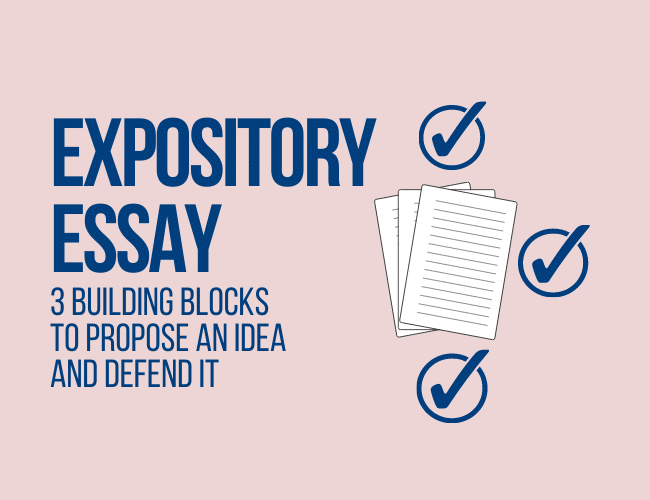If you saw the words “expository essay” on a writing assignment, would your mind draw a blank? Would you immediately feel as if you had stumbled into unexplored territory?
Well, there's good news.

This post is written by guest writer Dixie-Ann Belle. You can learn more about Dixie-Anne at the end of this article. Welcome, Dixie-Ann!
You might not realize it, but chances are this is not your first encounter with this type of essay. Once you have been writing essays in academic environments, you have probably already worked on expository writing.
In this article, I hope to help you recognize this essay type and understand the expository essay outline. Comprehending the building blocks is instrumental in knowing how to construct an exceptional expository essay.
Lay a Strong Foundation
Over the years, I have taught and tutored college students one on one as they write academic essays, in face-to-face classrooms and online, and I have noticed a pattern. They often approach essays in one of two ways.
Some consider them with apprehension and are fearful of making mistakes. Others feel confident that they have written many essays before and think they have already mastered expository writing.
Interestingly, it's the latter who often end up the most shaken when they realize that they are not as familiar as they think with this type of writing.
What I hope to instill in my students is that they should not feel intimidated whatever their situation or essay assignment.
I encourage them to make sure they understand the foundations of the expository essay structure. I try to get them to grasp the basic blocks that need to be there, and once they do, they have a good chance of crafting a substantial piece of writing.
What is an Expository Essay?
Students are typically assigned one of at least four types of essays: the persuasive/argumentative essay, the descriptive essay, the technical essay, or the expository essay.
Writing an expository essay is one of the most important and valuable skills for you to master.
An expository essay definition according to the Purdue Online Writing Lab:
The expository essay is a genre of essay that requires the student to investigate an idea, evaluate evidence, expound on the idea, and set forth an argument concerning that idea in a clear and concise manner.
Keep in mind that your expository writing centers on giving your reader information about a given topic or process. Your goal is to inform, describe, or define the subject for your readers.
As you work to achieve this, your essay writing must be formal, objective, and concise. No matter what your discipline, it's almost guaranteed that you will be required to write this common type essay one day.
Some expository essay examples could include:
- Define the term ‘democracy'
- Compare and contrast the benefits of cable television vs streaming
- Outline the process that generates an earthquake
- Classify the different types of tourism
- Outline the aspects of a good fitness program
The possibilities are endless with expository writing, and it can cover a wide variety of topics and specialties.
3 Building Blocks of a Great Expository Essay
To make sure you're on the right track with this type of paper, it helps to understand the three building blocks of the expository essay format and how to apply them to the final expository essay structure .
1. Write an introduction
Most students know that an introductory paragraph should grab the interest of the reader. However, they might not realize that it should also provide context for the essay topic.
Ask yourself: What are you talking about in this essay? Why is this topic important? Some background details could help to establish the subject for your reader.
For example:
If you were writing an essay on the impact smartphones have on society, you might want to start with some information on the evolution of smartphones, the number of smartphones in society, the way people use the phones and more.
The introduction should start off with general information.
You then work your way down to the more specific and principal part of your introduction and the crown of your whole essay, the thesis statement.
What is the thesis statement?
Your thesis statement states in concise language what this essay is going to be about. It is one clear sentence which expresses the subject and the focus of this piece of writing. If there is a prompt, the thesis statement should directly answer that prompt.
For example:
Our smart phones topic might create a thesis statement like: Smart phones have many positive impacts for adults in the business world.
Right away the reader has some idea of what's ahead.
2. Write your body paragraphs
With your thesis statement clear in your mind and your introduction setting the scene, it is time to write your body paragraphs.
Each body paragraph contains supporting information, including factual evidence for your essay topic. Each paragraph should each focus on one idea.
Depending on your word count and teacher's requirements, you can write any number of body paragraphs, but there are usually at least three for a basic five-paragraph essay.
Each body paragraph should start with a topic sentence. A topic sentence is one single statement that explains the point of the paragraph. It directly refers to your thesis statement and tells you what the body paragraph is going to be about.
Remember our smart phone thesis statement? You need something that will relate to that thesis sentence and will alert the reader to what is to come.
Here's one possibility:
Smart phones can help increase productivity for professional adults.
This topic sentence not only reminds us that you are talking about positive impacts for adults with smart phones, it now shows us what the following paragraph will cover.
The best body paragraphs will go on to include different types of details, all of which would support your topic sentence. A good abbreviation to encapsulate the different details is spelt TEEES.
The TEEES Body Paragraph Structure
Let's break down this abbreviation and explore the types of details you'll need in your body paragraphs
T: Topic sentence
You'll begin with your topic sentence establishing the purpose of this paragraph. We'll use our example from above:
Smartphones can help increase productivity for professional adults.
E: Explanation
This is where you expand on your topic and include additional supportive information.
If you were talking about smartphones and productivity, maybe you could mention what elements of the smartphone make it optimal for productivity.
E: Evidence
This is the information from reputable sources you researched for your topic. Here's where you can talk about all the information you have discovered from experts who have carefully studied this subject.
For our smartphone essay, perhaps you could mention a quote from a technology reporter who has been following the rise of smartphones for years.
E: Examples
This would be concrete subject matter to support your point.
Maybe here you can list some of the smartphone apps which have proven to increase productivity in the workplace.
S: Significant/Summarizing sentence
This is the last sentence in the body paragraph which summarizes your point and ends this part of your essay. There should be no doubt in the reader's mind that you have finished talking about your topic, and you are moving on to another in the next paragraph. Here's how we could conclude this paragraph on smartphones and productivity:
Smartphones have transformed the productivity of the modern workforce.
3. Write the conclusion
Once you have written your body paragraphs, you're in the home stretch. You have presented all of your points and supported them with the appropriate subject matter. Now you need to conclude.
A lot of students are confused by conclusions. Many of them have heard different rules about what is supposed to be included.
One of the main requirements to keep in mind when ending an expository essay is that you do not add new information.
This is not the time to throw in something you forgot in a previous body paragraph. Your conclusion is supposed to give a succinct recap of the points that came before.
Sometimes college students are instructed to re-state the thesis, and this puzzles them. It doesn't mean re-writing the thesis statement word for word. You should express your thesis statement in a new way.
For example, here's how you could approach the conclusion for our smartphone essay.
You've come up with three points to support your thesis statement, and you've explored these three points in your body paragraphs. After brainstorming, you might decide the benefits of smartphones in the workplace are improved productivity, better communication, and increased mobility.
Your conclusion is the time to remind your reader of these points with concise language. Your reader should be able to read the conclusion alone and still come away with the basic ideas of your essay.
Plan Your Essay Based on an Expository Essay Outline
While writing fiction, it is sometimes okay to “pants” it and just leap into writing your story.
When writing essays in academia, this is rarely a good idea. Planning your essay helps organize your ideas, helps you refine many of your points early on and saves time in the long run.
There are lots of great brainstorming techniques you can use to get your ideas together, but after that, it's time to create a topic to sentence outline.
There are three steps to creating your topic to sentence essay outline.
- Develop a powerful thesis statement. Remember, this is the overarching idea of your entire essay, so you have completed a significant step once you have one done.
- Come up with the ideas you would like to support your thesis statement.
- Based on your points, craft your topic sentences.
Here is an example of a topic to sentence outline:
| Thesis Statement: Smartphones have many positive impacts for adults in the business world. | |
| Topic | Topic Sentences |
| Productivity | Using smartphones can result in increased productivity for professional adults. |
| Communication | Smartphones can lead to improved communications among employees. |
| Mobility | As a result of using smartphones, business people can be more mobile with their work. |
Having these important foundation details completed is a great way to develop your essay as you build on each part. It is also an effective method to make sure you are on the right track.
Depending on your instructor (or tutor, if you have one), you can show your outline to them to get feedback before you launch into your entire essay.
Even if you don't have anyone to provide a critique, the outline can make it easier to revise how you will approach the rest of your paragraph essay.
You now have some firm foundations to help you as you construct your expository essay.
How do you organize an expository essay? Let us know in the comments.
PRACTICE
Take fifteen minutes to practice writing your own expository essay.
First, choose an expository writing assignment topic. If you can't think of one, use one of the expository essay examples below.
- What are the nutritional elements of a healthy breakfast?
- What are some of the most influential types of music?
- Compare and contrast the benefits of electric and gas cars.
- What are the major steps to planning a stress-free vacation?
- How do smartphones affect mental health?
- Define true love.
Craft a thesis statement about your topic. Then, write three topic sentences for your body paragraphs.
With the time you have left, start writing your essay. You might be surprised how much you can write in fifteen minutes when you have a clear outline for your essay!
When your time is up, share your outline and your expository writing in the Pro Practice Workshop here. After you post, please be sure to give feedback to your fellow writers.
Not a member yet? Join us here.
Happy writing!
Dixie-Ann Belle
Since she started scribbling stories in her notebooks as a child, Dixie-Ann Belle has been indulging her love of well crafted content. Whether she is working as a writing teacher and tutor or as a freelance writer, editor and proofreader, she enjoys helping aspiring writers develop their work and access their creativity.



0 Comments